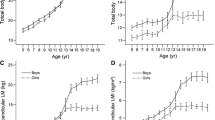Abstract
Objective
To prepare percentile charts of lean body mass (LBM) among Indian urban children and adolescents; and to evaluate gender differences in LBM, and its relation with pubertal status.
Design
Secondary data analysis.
Setting
School in city of Delhi, India.
Participants
1403 apparently healthy children and adolescents (826 boys) with mean (SD) age 13.2 (2.7) years.
Outcome measures
Lean body mass assessed by dual energy absorptiometry.
Results
Total and regional lean mass were greater in older age groups in both sexes. LBM showed rising trends up to the age of 18 years in boys, whereas it plateaued after the age of 15 years in girls. The age-associated increase in LBM was significantly higher in boys (130%) compared to girls (83%) (P<0.001). Total and regional lean mass increased with progression of pubertal staging in both genders. During pubertal development, LBM almost doubled (100% increase) from stage-2 to stage-5 in boys, as opposed to a 73% rise in girls (P<0.001). Total and regional lean mass and Appendicular skeletal muscle mass index (ASMI) was positively correlated with age, body mass index (BMI), serum 25(OH)D, total fat mass, and bone mineral content (BMC). Relation between LBM and BMC remained significant even after adjusting for age, fat mass and various biochemical parameters.
Conclusion
Total and regional LBM rise with age and pubertal maturation in both genders, but more so in boys when compared to girls. LBM has direct bearing on BMC even after adjusting for age, fat mass and biochemical parameters.
Similar content being viewed by others
References
Von Haehling S, Morley JE, Anker SD. An overview of sarcopenia: facts and numbers on prevalence and clinical impact. J Cachexia Sarcopenia Muscle. 2010;1:129–33.
Mithal A, Bonjour JP, Boonen S for IOF CSA Nutrition Working Group. Impact of nutrition on muscle mass, strength, and performance in older adults. Osteoporos Int. 2013;24:1555–66.
Boot AM, Bouquet J, de Ridder MA, Krenning EP, de Muinck Keizer-Schrama SM. Determinants of body composition measured by dual-energy X-ray absorptiometry in Dutch children and adolescents. Am J Clin Nutr. 1997;66:232–8.
Wells JC. Sexual dimorphism of body composition. Best Pract Res Clin Endocrinol Metab. 2007;21:415–30.
Courteix D, Lespessailles E, Loiseau-Peres S, Obert P, Ferry B, Benhamou CL. Lean tissue mass is a better predictor of bone mineral content and density than body weight in prepubertal girls. Rev Rhum Engl Ed. 1998;65:328–36.
Weber DR, Moore RH, Leonard MB, Zemel BS. Fat and lean BMI reference curves in children and adolescents and their utility in identifying excess adiposity compared with BMI and percentage body fat. Am J Clin Nutr. 2013;98: 49–56.
Pudowski P, Matusik H, Olszaniecka M, Lebiedowski M, Lorenc RS. Reference values for the indicators of skeletal and muscular status of healthy Polish children. J Clin Densitom. 2005;8:164–77.
Zhu K, Greenfield H, Zhang Q, Du X, Ma G, Foo LH, et al. Growth and bone mineral accretion during puberty in Chinese girls: a five-year longitudinal study. J Bone Miner Res. 2008;23:167–72.
Xu L, Nicholson P, Wang Q, Alén M, Cheng S. Bone and muscle development during puberty in girls: a seven-year longitudinal study. J Bone Miner Res. 2009;24:1693–8.
Wey HE, Binkley TL, Beare TM, Wey CL, Specker BL. Cross-sectional versus longitudinal associations of lean and fat mass with pQCT bone outcomes in children. J Clin Endocrinol Metab. 2011;96:106–14.
Shivaprasad C, Marwaha RK, Tandon N, Kanwar R, Mani K, Narang A, et al. Correlation between bone mineral density measured by peripheral and central dual energy Xray absorptiometry in healthy Indian children and adolescents aged 10-18 years. J Pediatr Endocrinol Metab. 2013;26:695–702.
Marwaha RK, Tandon N, Reddy DR, Aggarwal R, Singh R, Sawhney RC, et al. Vitamin D and bone mineral density status of healthy schoolchildren in northern India. Am J Clin Nutr. 2005;82:477–82.
Tanner JM. Growth at Adolescence: With a General Consideration of the Effects of Hereditary and Environmental Factors Upon Growth and Maturation From Birth to Maturity. Blackwell Scientific Publications, Oxford, 1969.
Wardhaugh B. Pubertal Staging. Available From: http://www.patient.co.uk/doctor/Puberty-Normal-and-Abnormal.htm. Accessed December 01, 2015.
Marwaha RK, Garg MK, Tandon N, Mehan N, Sastry A, Bhadra K. Relationship of body fat and its distribution with bone mineral density in Indian population. J Clin Densitom. 2013;16:353–9.
Ferretti JL, Capozza RF, Cointry GR, García SL, Plotkin H, Alvarez Filgueira ML, et al. Gender-related differences in the relationship between densitometric values of wholebody bone mineral content and lean body mass in humans between 2 and 87 years of age. Bone. 1998;22:683–90.
Borrud LG, Flegal KM, Looker AC, Everhart JE, Harris TB, Shepherd JA. Body composition data for individuals 8 years of age and older: U.S. population, 1999-2004. Vital Health Stat. 2010;250:1–87
Mølgaard C, Michaelsen KF. Changes in body composition during growth in healthy school-age children. Appl Radiat Isot. 1998;49:577–9.
Wang Z, Heo M, Lee RC, Kotler DP, Withers RT, Heymsfield SB. Muscularity in adult humans: proportion of adipose tissue free body mass and skeletal muscle. Am J Hum Biol. 2001;13:612–19.
Author information
Authors and Affiliations
Corresponding author
Rights and permissions
About this article
Cite this article
Marwaha, R.K., Garg, M.K., Bhadra, K. et al. Lean body mass and bone health in urban adolescents from northern India. Indian Pediatr 54, 193–198 (2017). https://doi.org/10.1007/s13312-017-1029-y
Received:
Revised:
Accepted:
Published:
Issue Date:
DOI: https://doi.org/10.1007/s13312-017-1029-y




